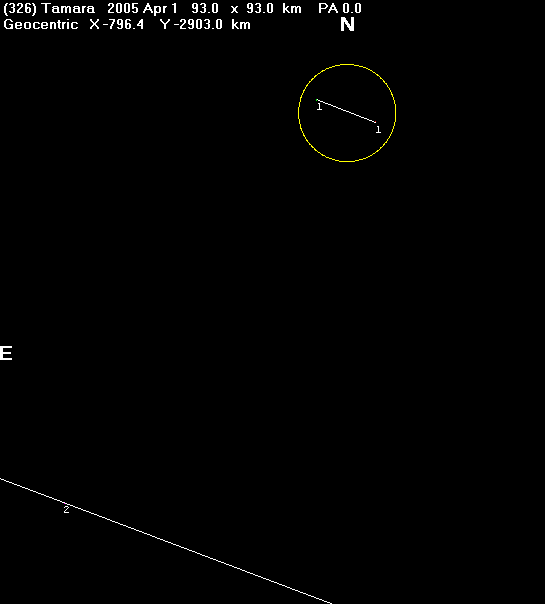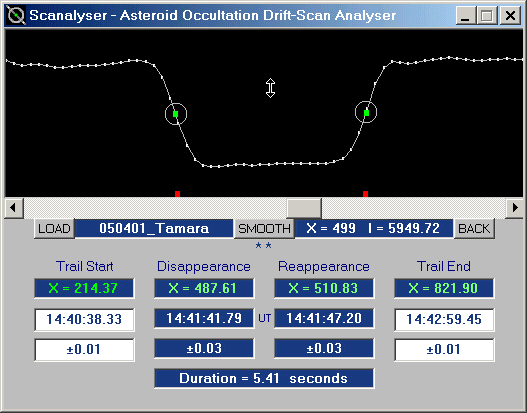A 5.41 second occultation was recorded using the CCD drift-scan technique by John Broughton in Reedy Creek, Queensland..
View the Updated Prediction
Observers: 1 J.Broughton, Reedy Creek, Australia 2(M) D.Gault, Hawkesbury Hts, Australia M = Miss

The circle represents the predicted 93 km diameter of Tamara.
Drift-scan trace:

Scanalyser Trace:

Discussion:
This is an excellent result, showing the enormous potential of the CCD drift-scan technique for yielding high quality occultation data.
Observational Data:
Observer's Name : John Broughton
Aperture (cm) : 50.1
Focal length (cm) : 140
Type (e.g. SCT; Newtonian) : Newtonian
Magnification : CCD drift-scan, 4.3 pixels per second
Observing site name : Reedy Creek, Gold Coast
Longitude (East +ve) : +153 23' 49"
Latitude (South -ve) : -28 06' 36"
Height above Sealevel (metres) : 66
Geodetic Datum (e.g.WDD84,NZ1949): AGD66
Sky Transparency (Delete two) : Good
Star Image Stability (Delete two): Good
Other Conditions:
(Wind, Clouds, Lights, etc.): None
Time Source (e.g. WWV, VNG) : WWVH
Recording method (e.g. tape) : Tape
Could you see the Asteroid? : Only combined light monitored though
asteroid is visible during occultation.
Approx. Limiting Magnitude : 14.5
| Estimated |
Universal Time | Reaction | Accuracy, Remarks
h m s | Time (sec) |
Started Observing : 14:40:38.33 n/a 0.01
Disappearance At : 14:41:41.79 n/a 0.03
Reappearance At : 14:41:47.20 n/a 0.03
Stopped Observing : 14:42:59.45 n/a 0.01
Duration : 5.41
ADDITIONAL COMMENTS:
A clear spell was a welcome change after 2 favorable occultations were
clouded out recently, including one by the same asteroid 3 nights before.
This is a sidereal rate drift-scan observation using methods described
at http://www.users.bigpond.com/reedycrk/driftscantiming.htm and is my
first positive result since the software was developed several months ago.
I was keen to try out a recently made 3 element F/2.7 focal reducer to in
effect slow down the drift rate, reduce seeing variations and improve SNR.
The field of view is wider, allowing longer exposures when necessary.
The Tamara exposure however was limited to 140 seconds to avoid overlap
by a brighter star to the east and good seeing conditions contributed
to an excellent image. The quality of the profile was further improved
by application of the smoothing filter in Scanalyser.
The considerable depth of the occultation in comparison with the remaining
variations led to a record measurement accuracy around a tenth of a pixel,
producing a first-class timing accuracy of 0.03 second!
Observational Data - Occultation Not Seen:
Observer's Name : Dave Gault Aperture (cm) : 25 Focal length (cm) : 122 Type (e.g. SCT; Newtonian) : EQ Newtonian Magnificatio : PC164C at Newtonian Focus Observing site name : Dave's Skyshed Longitude (East +ve) : 150 38.4637 Latitude (South -ve) : -33 39.8663 Height above Sealevel (metres) : 286 Datums : WGS84 and MSL Sky Transparency (Delete two) : Good Star Image Stability (Delete two): Good Other Conditions: : moonlight Time Source (e.g. WWV, VNG) : GPS Recording method (e.g. tape) : KIWI Could you see the Asteroid? : Yes observed <1 arcmin to separation Approx. Limiting Magnitude : 13.8 : UT Time | PE | Accuracy | Remarks Started Observing : 13:13 Star and Object Merged : 14:37 Star and Object Separated : 14:47 Stopped Observing : 14:50 ADDITIONAL COMMENTS: As the moon was up I gave myself plenty of time and found the target star 1 1/2 hours before time. With the glare from the moon it was difficult to see (visually) the mag 10.9 target star but once the PC164 camera was pressed into service it became easy. The limiting mag. was 13.8 and it was fun to watch the mag. 11.9 asteroid appulse the star from <1 arcmin separation. The asteroid and star merged at 14:37UT and separated at 14:47UT. Alas no occultation was observed.
[Top of Page][Return to Home Page]